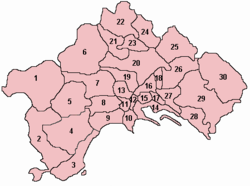Scampìa
Coordinates: 40°54′07.83″N 14°14′09.91″E / 40.9021750°N 14.2360861°E

Scampìa is a modern suburb in the north of Naples. The population is about 80,000.
Geography
The district lies in the far north of Naples. To the south are the suburbs of Piscinola-Marianella, Miano and Secondigliano.
History
Scampia was built as a bedroom suburb in 1960s. The area was mostly developed in the 1970s and 1980s, with huge, high-rise residential blocks, in particular after the 1980 earthquake with construction of housing for displaced Neapolitans. Huge apartment complexes, wide boulevards and a massive park were built, without commercial districts or entertainment venues.[1] With 50% unemployment, the area has a very high crime rate, with heroin and cocaine sold and used openly in the streets.[2]
Large metal gates on some of the walkways and stairs in the blocks of flats have been put there, not by the council, but by the Camorra, so they can be locked by drug pushers as they flee the police.[3]
Scampia was the territory of the Di Lauro clan, which controlled the drug trade and most other activities in the area. In 2004 a bloody gang war erupted in the area, the so-called Scampia feud (Faida di Scampia), between the Di Lauro clan and a breakaway fraction, the so-called "secessionists" (Italian "scissionisti").[4][5]
The death of an innocent woman, Gelsomina Verde, caused widespread public revulsion and led to a major crackdown by the authorities. She was abducted, brutally beaten in an effort to get her to disclose the whereabouts of a gang member involved in the feud, and finally shot in the neck. Her body was stuffed in a car that was set on fire.[6]
Scenes from the movie Gomorrah were filmed in the neighbourhood.[7]
Vele di Scampia
The Vele di Scampia (English: Sails of Scampia) is a large urban housing project built between 1962 and 1975 in the Scampia neighbourhood. They were named for their triangular shape buildings, reminiscent of a sail (wide at the base, narrowing as they rise), similar to Marina Baie des Anges in Villeneuve-Loubet, France.
Built as a result of Law 167, passed in 1962, the seven Sails of Scampia (designed by Franz Di Salvo) were part of a project which also included development of the city of Naples to the east, in Ponticelli. They remain, despite everything, the work carried out which best represents the architectural poetics of Franz Di Salvo. Di Salvo's debut in popular, but low-cost, architectural design dates back to 1945 with the completion, in collaboration with other architects, of the District of Cesare Battisti Poggioreale, which then represented the paradigm of a "new way of thinking" about social housing.
After years of continuous design experiments, the task of establishing a large apartment complex in Scampia was entrusted to the Cassa del Mezzogiorno. Inspired by the principles of Les unités d'habitations of Le Corbusier, by the "a cavalletto" structures proposed by Kenzō Tange, and, more generally, by macro-structural models, Di Salvo articulated a plan of the district which was based on two building types: a "tower" and "tent." The latter type provides the dominant image of all the sails, which are characterized (in sectional view) by the combination of two buildings with tilted lamellar construction, separated by a large central space through the long galleries suspended between the levels of the housing units. They were also provided with social centers, a play space, and other community facilities. Failure to fulfill this "core of socialization" was certainly a contributory cause of failure.
The failure of Le Vele
The Sails of Scampia buildings are in a state of decay, although the two buildings are still occupied by residents.
The idea behind the project was to provide a huge housing settlements where hundreds of families can integrate and create a community. With rail tracks and large park areas between the different sails, the planners wanted to create a small city model with large parks, playing fields and other facilities, and multiple-lane roads.
However, various causes have led to what is now regarded as a ghetto. Right after the earthquake in 1980, many families in the area were left homeless. Many of these families without shelter started to occupy the apartments illegally. Tolerated and ignored by the government, more people started to occupy the buildings including criminals.
Things were made worse by the total lack of state presence, resulting in drug trafficking, illegal street racing, gangs, and dealing in stolen goods. The first police station for the area was established in 1987, exactly fifteen years after people began occupying the apartments.
Le Vele in literature
Le Vele Scampia is featured by poet and writer Emanuele Cerullo, a resident of one of the sails. He described through poetry the dreams and hopes of Scampia's adolescents, portraying a different view of reality than the media.
Gerald Seymour's 2009 novel The Collaborator uses The Sail as the setting for its denouement.
Notes and references
- ↑ In Naples, a Mob Family Feud, The Washington Post, February 8, 2005
- ↑ Mafia vice blights Naples school, BBC News, November 30, 2004
- ↑ Weekends turn bloody in Naples mafia war, The Guardian, December 18 2004
- ↑ Naples police in huge mafia swoop, BBC News, December 7, 2004
- ↑ Gang's Deadly Feud Plagues Naples, Los Angeles Times, February 17, 2005
- ↑ 'The blood is running': Mafia wars erupt again, The Independent, December 8, 2004
- ↑ Streets of 'Gomorrah', Newsweek magazine issue dated December 22, 2008
External links
- (English) Drug, feuds and blood in the land of the Camorra - SCAMPIA 24 Video-documentary of the newspaper Il Mattino
- (Italian) L'Altra Scampia video documentary on Scampia
- (Italian) Ballarò: droga a Scampia (Secondigliano, Napoli) video report on drug trafficking in Scampia
- Scampia Camorra Napoli Ground Zero video impression
| ||||||||||||